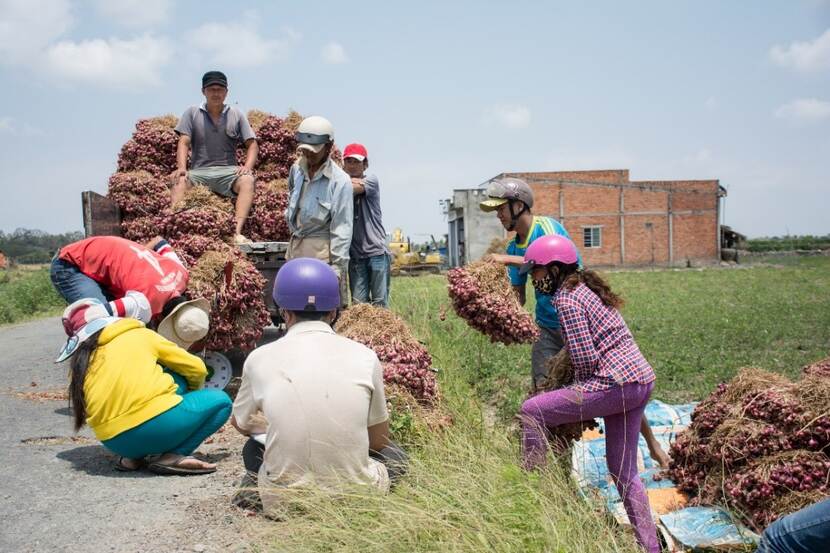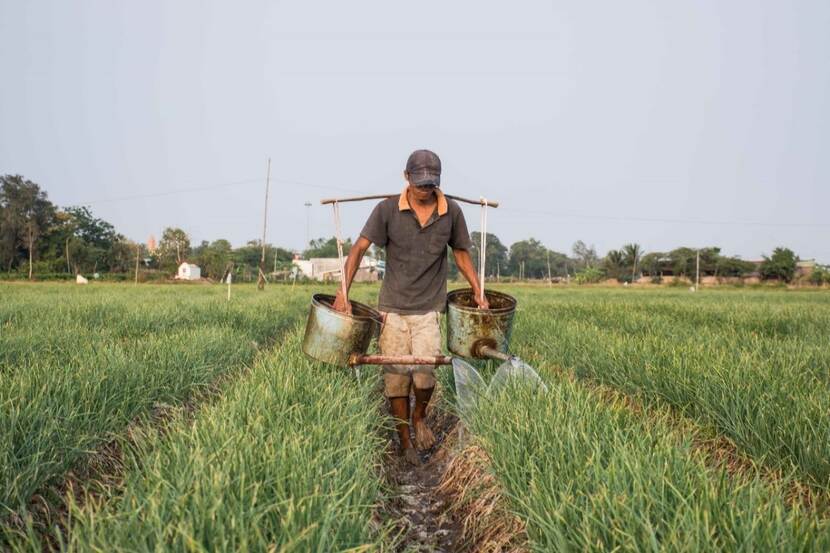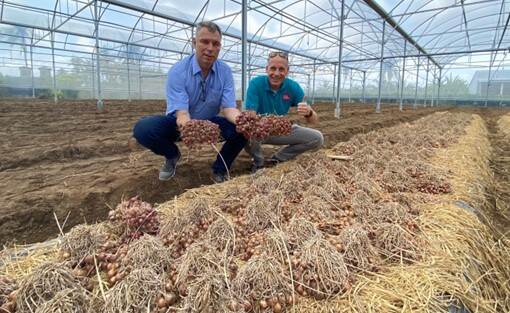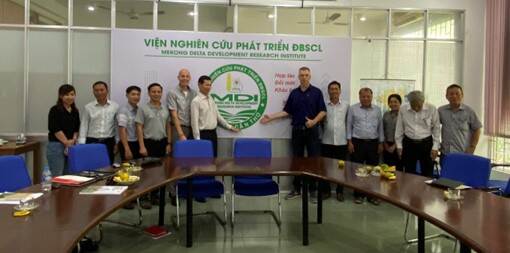Transition towards sustainable shallot value chains in the Mekong Delta
Maybe unknown to many but shallot is one of the key vegetable crops in the Mekong Delta, generating one of the highest income contributions per m2 and month. One of the most important production areas for shallot in Vietnam, is Vinh Chau district in Soc Trang province in the Mekong Delta. Shallots are a crucial source of income for farmers and workers, who mostly belong to the Khmer ethnicity. Poverty incidence among the Khmer, are one of the highest in the Mekong Delta. For those Khmer who have been able to switch to shallot farming, this has been one of the few pathways to grow out of poverty. Just the shallot sector in Vinh Chau district created jobs for about 70,000 Khmer.

High use of ground water
Although shallot has been an important crop to reduce poverty among the Khmer, the current farming system is putting pressure on the environment, as currently large amounts of ground water is used to produce shallots in an inefficient way. Based on data collection by Fresh Studio, the volume of ground water being used for one shallot crop cycle being cultivated on 1,000 m2 is estimated to be 220.5 m3. The volume of 220.5 m3/1,000 m2 per crop cycle, means 2,205 m3/ha per crop cycle. If we multiply this number times the 6,000 ha of shallot cultivation in Vinh Chau, this means that in the main shallot season an estimated 13,230,000 m3 of ground water is used for shallot production. This is equal to 189,000 m3 of ground water per day for 70 days, which is an enormous amount of water. There are two key reasons for this high use of water:
- Inefficient irrigation methods
- At least one to two crop cycles to produce the shallot bulbs used as propagation material, before the main shallot crop is grown. These shallot bulbs cropping cycles for propagation material also require quite some water.
The extraction of ground water for shallot production leads to land subsidence in Vinh Chau district. Land subsidence makes the Mekong Delta more vulnerable to the rising sea levels and accelerates salinization.

Current irrigation method
That farmers mainly use ground water, through their own drilled wells for irrigation water is confirmed by a study among 90 farm households in Vinh Chau district in Soc Trang Province, of which 85% use groundwater from drilled wells during the dry season. Unfortunately, this groundwater is then used in an inefficient way, mainly delivered in buckets, whereby only 20% of the irrigation water reaches the crop, according to the head of the Soc Trang department of irrigation (Vietnamnet, 2013).
This current inefficient irrigation methods, are confirmed by a study by Can Tho university with sprinkler irrigation on shallots in Vinh Chau. This improved irrigation system resulted in a 43-59% reduction in water use and an income increase of 20% (Hong Minh Hoang et al, 2016). The Asian Development Bank in a paper published in 2017 also identifies the implementation of high efficiently irrigation systems (HEIS), such as sprinklers and drip irrigation, as a key strategy to reduce the amount of water used per kg of crop produced. Bringing these technologies to smallholder farmers in the Mekong Delta would be an important innovation and one that would be supported by government policy, which has recommended that HEIS be adopted more widely.
Shallot bulbs
Currently farmers produce their own shallots bulbs as propagation material, to produce consumption shallots in the December- March period which they sell to traders. To produce these shallot bulbs, they use a part of the harvest of the December - March, and then plant those shallots bulbs again in very high density to produce bulbs as propagation material to be used for next season. They produce the shallot bulbs as propagation material in the Feb-April period, after which they need to store the shallot bulbs till December of the new production season. During this storage period from April till November about 30-40% of the shallot bulbs stored as propagation material for the next shallot production season, will be lost (mainly due to Fusarium). As a result of losses, many farmers produce yet another shallot bulb crop in November – December, using additional water without increasing productivity. In addition to significant post-harvest losses and the high costs to produce the shallot bulbs as propagation material, the shallot bulb production also has the big disadvantage of propagating diseases, thereby reducing productivity in future harvests as well.
Tropical hybrid shallot variety
A new tropical hybrid shallot variety (Maserati) developed by the Dutch seed company Bejo Zaden B.V. enables shallot farmers to produce shallots from seeds. Maserati is based on the genetic material of the Vinh Chau shallot and therefore has the same appearance and taste. These shallot seeds can be sowed directly in the field or first used to produce shallot seedlings, which are then transplanted in the field to produce shallots. Because these true shallot seeds are hybrid and will be guaranteed disease free, the farmer will get higher yields and a better pest and disease resistance. In addition, they will not have to spend one or two seasons on producing and storing the shallots bulbs as propagation material. Even though the seed price might be higher, starting with hybrid shallot seedlings (produced from seeds), will have an enormous impact on increasing farm income and will halve their use of ground water for shallot farming.

Adaptation of innovative and sustainable production practices, such as sprinkler or drip irrigation, irrigation decision support tools, fertilizer application advise and integrated pest and diseases management to name a few will further increase the positive impact on farmer’s income, water use efficiency and reduce the agro-chemical footprint of shallot production on the environment.
Impact Cluster: combining technologies and knowledge

This is also an important reason why this impact cluster is formed, as just introducing hybrid shallot seeds to shallot farmers is not the optimal solution. The combination of the knowledge and technologies of the impact cluster partners enables the cluster to establish and introduce shallot farmers the system to start their shallot production from hybrid shallot seedlings. The creation of nurseries specialized in producing hybrid shallot seedlings and mini bulbs provides an opportunity to generate additional income and jobs in the region. As part this project the following parties collaborate together: Bejo zaden, Groot & Slot, Royal Brinkman, BvB Substrate, Eurofins, Can Tho University and Fresh Studio.
Project objective
The main objective of the impact cluster “Transition towards sustainable shallot value chains in the Mekong Delta” is to strengthen the shallot production sector in the Mekong Delta (Soc Trang province, > 6,000 hectares of shallot production), by introducing and making innovative Dutch production technologies and methods accessible for local shallot farmers, which will make shallot production more sustainable and profitable. The impact cluster will further strengthen the adoption of these improved production technologies, by creating market linkages for the shallot farmers, so that a sustainable shallot value chain is developed.
Project activities
Through this impact cluster an important contribution will be made to address excessive and inefficient water use by shallot farmers in the Mekong Delta. In the area of Vin Chau district of Soc Trang Province, shallot farming is the second largest agricultural land use activity. This type of land use is contributing to one of the highest rates of subsidence in the Mekong Delta (Minderhoud et al, 2018), making the shallot sector a key contributor to reduced water security in the region. By increasing water use-efficiency, the extraction of ground water can be halved, which can help to reduce the rate of land subsidence.
The activities of the Impact Cluster to achieve the project objective are:
- Demonstrating optimized irrigation strategy and water use efficiency
- Demonstrating optimize technologies through hybrid shallot seedling and integrated pest and disease management
- Demonstrating optimized fertilizer application strategy
- Develop field days to showcase improved hybrid shallot production technologies
- Training programs in sustainable and improved hybrid shallot production for farmers
- Capacity building shallot sector stakeholders
- Creating market linkages for producers with domestic and export markets
Do you have any questions for the agriculture department at the Netherlands embassy in Vietnam please send an email to HAN-LNV@minbuza.nl. For the latest updates and more information follow us on Twitter @AgroVietnam